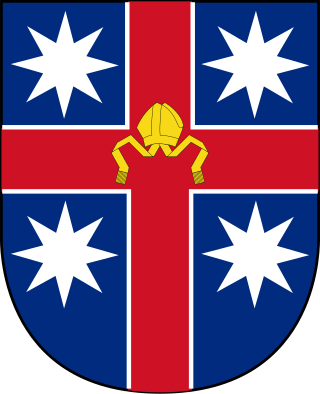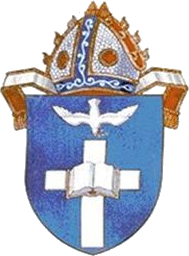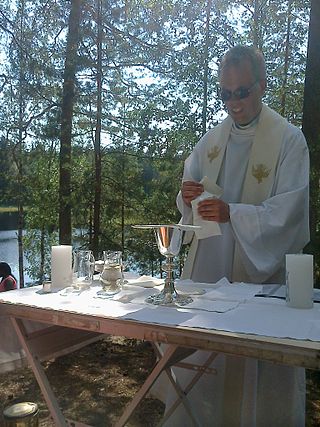
The House of Clergy is the middle house in the tricameral Church of England General Synod legislature. It consists of representatives of the ordained clergy of the Church of England.

The House of Clergy is the middle house in the tricameral Church of England General Synod legislature. It consists of representatives of the ordained clergy of the Church of England.
The House of Clergy comprises ordained members of the Church of England below the rank of bishop. Members are elected by their fellow clergy to represent their individual Dioceses at their regional Diocesan Synod. [1] Members are obliged to retire when they reach 70. [2] The House of Clergy, like the House of Bishops and House of Laity, hold veto power over all proposed Church of England Measures and reports. An example of this was when the House of Clergy vetoed a report on homosexuals and same-sex unions. [3] It comprises the Lower Houses of the Convocations of Canterbury and York. [4]
Elections to the House of Clergy take place every five years with by-elections held to fill any vacancies that may arise between elections. [5] In practice the members of the House of Clergy are identical to the members elected to the Convocations of Canterbury and York. [5] In order to be elected to the House of Clergy, the person must be an ordained member of the Church of England. A clergyman or women must be elected by the Deanery Synod of the area which includes the parish that they are licensed to work in, to the Diocesan Synod. From there, they must be elected by the members of the Diocesan Synod to the House of Clergy. [6] In 1987, following the decision to allow ordination of women as Deacons in the Church of England, women became eligible for election to the House of Clergy for the first time. [6] Members can also be co-opted and with a limited number being appointed. [7]
Membership consists of three elected representatives by each Diocese in the Province of Canterbury and the Province of York including the extraprovincial Diocese of Gibraltar in Europe and the Diocese of Sodor and Man (which only elects one member). [8] Other members elected include one for the Universities of Oxford, Cambridge, and London, one jointly for the Universities of Durham and Newcastle, four elected by the other Universities split between Canterbury and York and six Deans elected from Cathedrals, plus either the Dean of Jersey or the Dean of Guernsey. The appointed ex officio members are the three senior Chaplains of the British Armed Forces, the Chaplain-General of Prisons and two members selected by the Anglican religious orders. [8]

The Church of England is the established Christian church in England. It traces its history to the Christian church recorded as existing in the Roman province of Britain by the 3rd century and to the 6th-century Gregorian mission to Kent led by Augustine of Canterbury. Its adherents are called Anglicans.
An ecclesiastical court, also called court Christian or court spiritual, is any of certain courts having jurisdiction mainly in spiritual or religious matters. In the Middle Ages, these courts had much wider powers in many areas of Europe than before the development of nation states. They were experts in interpreting canon law, a basis of which was the Corpus Juris Civilis of Justinian, which is considered the source of the civil law legal tradition.
The General Convention is the primary governing and legislative body of the Episcopal Church in the United States of America. With the exception of the Bible, the Book of Common Prayer, and the Constitution and Canons, it is the ultimate authority in the Episcopal Church, being the bureaucratic facility through which the collegial function of the episcopate is exercised. General Convention comprises two houses: the House of Deputies and the House of Bishops. It meets regularly once every three years; however, the House of Bishops meets regularly in between sessions of General Convention. The Bishops have the right to call special meetings of General Convention.

The Anglican Church of Australia, formerly known as the Church of England in Australia and Tasmania, is a Christian church in Australia and an autonomous church of the Anglican Communion. It is the second largest church in Australia after the Catholic Church. According to the 2016 census, 3.1 million Australians identify as Anglicans. As of 2016, the Anglican Church of Australia had more than 3 million nominal members and 437,880 active baptised members. For much of Australian history since the arrival of the First Fleet in January 1788, the church was the largest religious denomination. It remains today one of the largest providers of social welfare services in Australia.
The Anglican Church in Aotearoa, New Zealand and Polynesia, formerly the Church of the Province of New Zealand, is a province of the Anglican Communion serving New Zealand, Fiji, Tonga, Samoa, and the Cook Islands. Since 1992 the church has consisted of three tikanga or cultural streams: Aotearoa, New Zealand, and Polynesia. The church's constitution says that, among other things, it is required to "maintain the right of every person to choose any particular cultural expression of the faith". As a result, the church's General Synod has agreed upon the development of the three-person primacy based on this three tikanga system. It has three primates (leaders), each representing a tikanga, who share authority.
The General Synod is the tricameral deliberative and legislative organ of the Church of England. The synod was instituted in 1970, replacing the Church Assembly, and is the culmination of a process of rediscovering self-government for the Church of England that had started in the 1850s.
In the Anglican Communion, the model of government is the 'Bishop in Synod', meaning that a diocese is governed by a bishop acting with the advice and consent of representatives of the clergy and laity of the diocese. In much of the Communion the body by which this representation is achieved is called the diocesan synod.
David Staffurth Stancliffe is a retired Church of England bishop. He was Provost of Portsmouth Cathedral from 1982 to 1993, and the Bishop of Salisbury from 1993 to 2010. He is the third generation of his family to serve the ordained ministry.

The Anglican ministry is both the leadership and agency of Christian service in the Anglican Communion. Ministry commonly refers to the office of ordained clergy: the threefold order of bishops, priests and deacons. More accurately, Anglican ministry includes many laypeople who devote themselves to the ministry of the church, either individually or in lower/assisting offices such as lector, acolyte, sub-deacon, Eucharistic minister, cantor, musicians, parish secretary or assistant, warden, vestry member, etc. Ultimately, all baptized members of the church are considered to partake in the ministry of the Body of Christ.

The Convocations of Canterbury and York are the synodical assemblies of the bishops and clergy of each of the two provinces which comprise the Church of England. Their origins go back to the ecclesiastical reorganisation carried out under Archbishop Theodore of Canterbury (668–690) and the establishment of a separate northern province in 733. Until 1225 the synods were composed entirely of bishops, but during the thirteenth century more and more clergy were cited until by 1283 the membership was established as the bishops, deans, archdeacons and abbots of each province together with one proctor (representative) from each cathedral chapter and two proctors elected by the clergy of each diocese. The main purpose of the convocations was to take counsel for the well-being of the church and to approve canonical legislation, but in practice much time was spent in discussing the amount of tax to be paid to the Crown since the clergy were a separate estate of the realm and refused to be taxed in or through Parliament. Before the end of the nineteenth century, the Convocation of Canterbury, which was numerically very much larger, played the major role and the activity of the Convocation of York was often little more than giving formal approval to the decisions taken by the southern province.

The Anglican Diocese of Armidale is a diocese of the Anglican Church of Australia located in the state of New South Wales. As the Diocese of Grafton and Armidale, it was created by letters patent in 1863. When the Anglican Diocese of Grafton was split off in 1914, the remaining portion was renamed Armidale, retaining its legal continuity and its incumbent bishop.
The Anglican realignment is a movement among some Anglicans to align themselves under new or alternative oversight within or outside the Anglican Communion. This movement is primarily active in parts of the Episcopal Church in the United States and the Anglican Church of Canada. Two of the major events that contributed to the movement were the 2002 decision of the Diocese of New Westminster in Canada to authorise a rite of blessing for same-sex unions, and the nomination of two openly gay priests in 2003 to become bishops. Jeffrey John, an openly gay priest with a long-time partner, was appointed to be the next Bishop of Reading in the Church of England and the General Convention of the Episcopal Church ratified the election of Gene Robinson, an openly gay non-celibate man, as Bishop of New Hampshire. Jeffrey John ultimately declined the appointment due to pressure.
The House of Laity is the lower house in the tricameral General Synod of the Church of England legislature. They are responsible for representing the laity of the Church of England in the legislature. They are indirectly elected every 5 years by members on the Church of England's electoral roll via the representatives on the Diocesan Synods.

The ordination of women in the Anglican Communion has been increasingly common in certain provinces since the 1970s. Several provinces, however, and certain dioceses within otherwise ordaining provinces, continue to ordain only men. Disputes over the ordination of women have contributed to the establishment and growth of progressive tendencies, such as the Anglican realignment and Continuing Anglican movements.

Vivienne Frances Faull is a British Anglican bishop and Lord Spiritual. Since 2018, she has served as the Bishop of Bristol. In 1985, she was the first woman to be appointed chaplain to an Oxbridge college. She was later a cathedral dean, and the only female cathedral provost in Church of England history, having served as Provost of Leicester from 2000 to 2002.
Glyn Hamilton Webster is a retired British Anglican bishop who was the Bishop of Beverley in the Church of England from January 2013 to January 2022. He was previously the canon chancellor and Acting Dean of York at York Minster in the Diocese of York.

Tuomas Mäkipää is an Anglican clergyman of Finnish Lutheran origin. He studied theology at Helsinki University.

Cherry Elizabeth Vann is a British Anglican bishop serving as Bishop of Monmouth in the Church in Wales. She previously served as Archdeacon of Rochdale from 2008 to 2020, having served all of her ordained ministry with the Church of England in the Diocese of Manchester.
Steven James Betts is a British Church of England priest. Since 2012, he has been the Archdeacon of Norfolk.
The House of Bishops is the upper house of the tricameral Church of England General Synod legislature. It consists of all 42 Diocesan Bishops of the Church of England's Provinces of Canterbury and York as well as nine elected suffragan bishops. This is not to be confused with the Lords Spiritual, the most senior bishops in the Church of England sitting in the House of Lords ex officio.